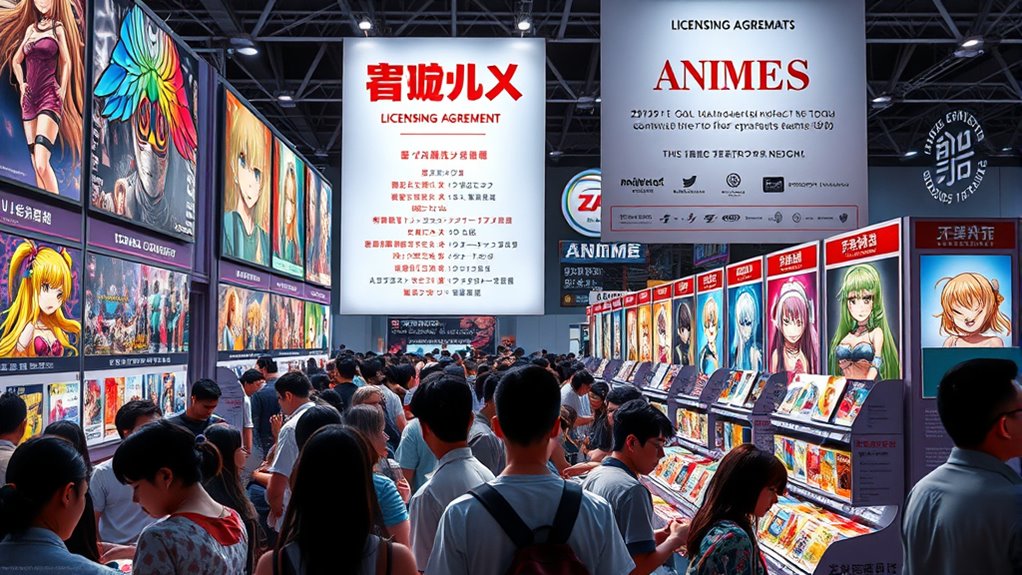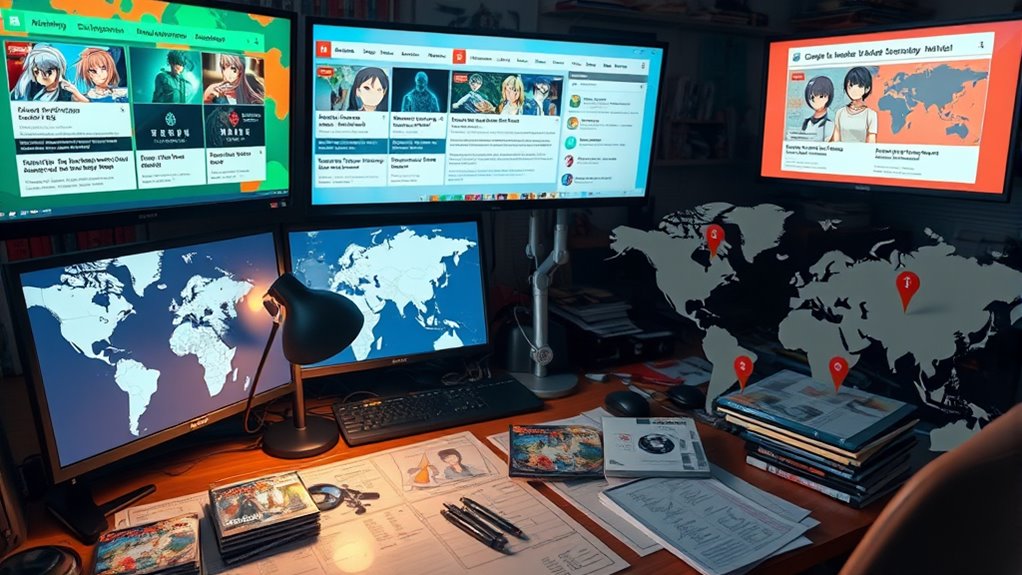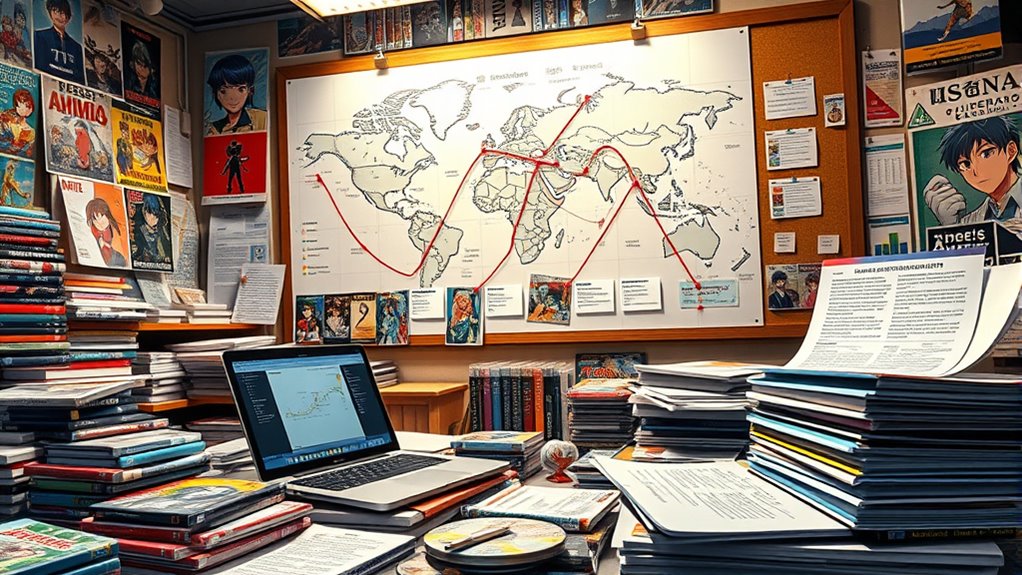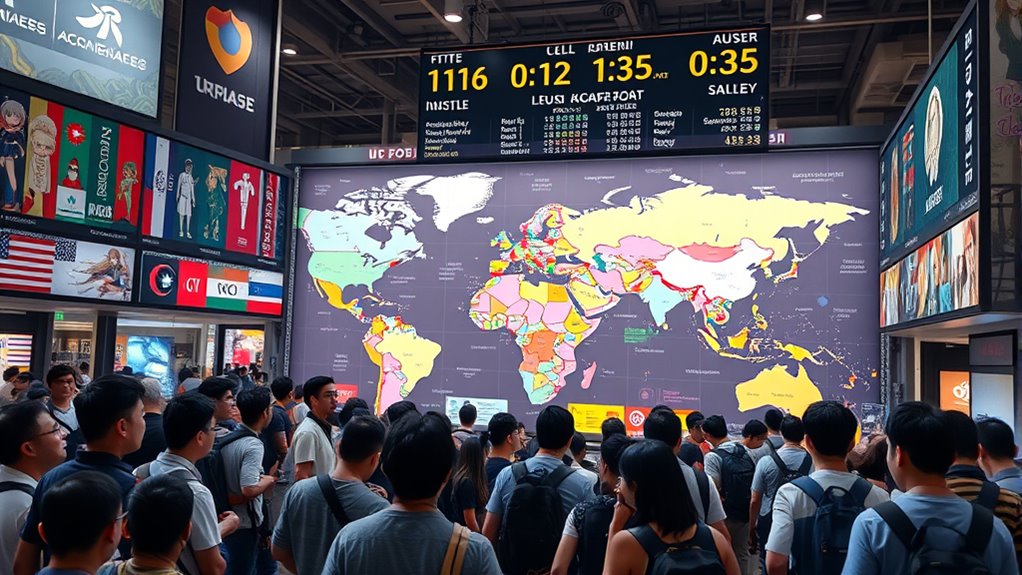Licensing wars impact your anime experience by causing delays, regional restrictions, and limited availability. When big companies compete for exclusive rights, they often delay international releases or restrict access in certain areas. This means you might not get your favorite titles straight away or face regional censorship. Streaming platforms and licensing disputes shape these schedules a lot. Stay with us to discover how industry strategies and next-gen licensing trends influence global anime launches.
Key Takeaways
- Licensing wars cause delays and regional restrictions, impacting the timing and availability of anime worldwide.
- Disputes over rights and revenue shares lead to postponed or canceled releases in certain territories.
- Exclusive licenses and regional deals often prevent simultaneous global launches, creating staggered release schedules.
- Content delays due to legal conflicts increase reliance on fan translations and unofficial streams.
- Negotiation conflicts influence release timing, shaping how quickly and broadly anime reaches international audiences.
The Role of Licensing Agreements in Anime Distribution

Licensing agreements are the backbone of how anime reaches global audiences. They determine where and how anime is distributed, shaping what viewers get to see and buy. When a license is secured, companies can produce anime merchandise, making figures, apparel, and collectibles available worldwide. These agreements also influence fan translations, as licensed regions often restrict unofficial subtitles, impacting how fans experience new releases. Without licensing, anime fans might turn to unofficial sources, risking quality and legality. Licensing agreements help establish official channels for distribution, ensuring creators and licensors benefit financially. Additionally, distribution rights are carefully negotiated to maximize reach and profitability. This system allows anime to grow beyond Japan, fueling international fandoms and markets. Ultimately, licensing agreements are essential for balancing commercial interests, protecting intellectual property, and satisfying global audiences enthusiastic for authentic anime experiences.
Major Players in the Licensing Arena

You’ll notice that a few major companies dominate the licensing scene, shaping how anime reaches global audiences. Their power dynamics influence negotiations and content rights, often giving them leverage over smaller studios. Understanding their market strategies helps you see why certain titles get priority and others struggle to find a foothold. For instance, the prominence of preppy dog names in branding and marketing efforts demonstrates how licensing strategies can extend beyond the anime industry into broader popular culture.
Power Dynamics Among Studios
In the competitive world of anime licensing, a handful of major studios dominate the landscape, shaping which series reach global audiences and under what terms. These studios hold significant influence through strategic studio collaborations, often pooling resources or sharing rights to maximize reach. Their power is evident in licensing negotiations, where they set terms that can favor their own interests or limit competitors’ access. This dynamic allows them to control the release schedule and distribution channels, often dictating timing and exclusivity deals. As a result, smaller studios or new entrants find it challenging to negotiate favorable terms, reinforcing the existing power hierarchy. These licensing negotiations often involve complex negotiations around rights, timing, and exclusivity, which further solidify the major players’ dominance. Ultimately, these power dynamics shape the global anime market, determining which series get prioritized and when audiences can enjoy them.
Market Competition Strategies
Major players in the licensing arena employ a variety of competitive strategies to secure and expand their market presence. They combat challenges like digital piracy and fan translations by offering exclusive content, timely releases, and localized versions. To stay ahead, they:
- Invest heavily in marketing and promotional campaigns
- Secure exclusive licenses for popular titles
- Develop official streaming platforms to reduce reliance on unauthorized sources
- Partner with regional distributors to control release schedules
- Implement linguistic variations to cater to diverse regional audiences and enhance localization efforts
These tactics help them minimize the impact of digital piracy and fan translations, ensuring legal revenue streams. By controlling distribution channels and providing high-quality, accessible content, they maintain a competitive edge in a rapidly evolving landscape where fans often turn to unofficial sources for early or untranslated episodes.
How Licensing Conflicts Delay International Releases

When rights disputes arise, anime studios often halt airings or delay releases worldwide. Contract battles between licensing companies can also push back launch dates, frustrating enthusiastic fans. These conflicts create roadblocks that keep popular series from reaching international audiences on time.
Rights Disputes Halt Airings
Licensing disputes often disrupt the release schedule of anime abroad, causing unexpected delays in international broadcasts. When rights are contested, broadcasters may hesitate to air episodes, fearing legal issues or copyright infringement. This can lead to frustration among fans enthusiastic for new episodes. Additionally, piracy concerns and fan translations complicate matters, as unauthorized streams or subtitles might circulate before official releases, pressuring licensors to resolve disputes quickly. Furthermore, AI-generated content and automated translation tools have introduced new challenges in verifying the authenticity and quality of licensed material. These disputes highlight how rights conflicts directly impact viewing schedules, often frustrating fans and complicating the global spread of anime. Resolving these issues is essential for smooth international releases.
Contract Battles Delay Launches
Contract battles between licensors and production companies often stall the release of anime outside Japan. These delays happen because legal negotiations over licensing terms can drag on, as both sides seek favorable deals. Copyright enforcement plays a vital role here, with licensors enthusiastic to protect their rights and prevent unauthorized distribution. When disputes arise, it can take months or even years to resolve the conflicts, pushing back international launch dates. Sometimes, disagreements over territorial rights or revenue shares lead to contractual deadlocks. As a result, fans in global markets face postponed access, and companies miss out on potential revenue. Additionally, licensing conflicts can lead to market instability, affecting how quickly new titles are made available worldwide. Ultimately, these contract battles highlight how licensing conflicts directly impact the timing and availability of anime worldwide.
Regional Restrictions and Their Impact on Viewership

Regional restrictions considerably influence how viewers access anime, often limiting availability based on geographic location. These restrictions are driven by regional censorship laws and licensing agreements, which can block certain content or entire series. As a result, your viewer accessibility varies widely depending on where you are. You might miss out on popular titles or encounter different versions with edits. To understand this better, consider:
- How regional censorship alters content for specific audiences
- Limited access to certain anime in some countries
- Delays or bans caused by licensing restrictions
- The impact on fans who want consistent viewing experiences
- Content availability is often shaped by regional licensing wars, which directly affect what you can watch and when.
These restrictions shape your anime experience, creating gaps and inconsistencies that reflect broader licensing wars. They highlight how regional licensing battles directly affect what you can watch and when.
The Influence of Streaming Platforms on Licensing Deals

Streaming platforms have become powerful players in the anime industry, shaping how licensing deals are negotiated and structured. They prioritize digital distribution, making content accessible worldwide but often impose regional exclusivity to attract subscribers in specific markets. This regional focus allows platforms to secure exclusive rights for certain territories, influencing release schedules and limiting simultaneous global releases. As a result, licensors tailor deals to maximize platform reach and revenue, sometimes delaying or restricting access in particular regions. You’ll notice that streaming services now drive licensing negotiations, emphasizing digital access over traditional broadcast rights. This shift not only affects how quickly fans access new anime but also alters the global landscape, as platforms compete for regional dominance through strategic licensing deals. Additionally, the reliance on digital distribution has increased the importance of flexible licensing arrangements to adapt to the evolving industry dynamics.
Case Studies of Notable Licensing Disputes

You’ve probably heard about major studios clashing over licensing rights, which often delays or blocks releases. These disputes can considerably affect when and where fans get access to new anime titles. Regional licensing battles also create confusion and frustration for viewers around the world. Understanding legal information can help fans navigate the complex landscape of licensing disputes and their implications.
Dispute Between Major Studios
Major studios often find themselves embroiled in licensing disputes that can substantially impact anime releases worldwide. These conflicts often stem from differing priorities, such as protecting intellectual property or maximizing profits, which directly affect fan expectations and localization challenges. When studios clash, you might see delayed or blocked releases, frustrating fans enthusiastic for access.
Consider these notable disputes:
- Negotiations over regional rights that stall release schedules
- Licensing refusals due to content restrictions and censorship issues
- Conflicting claims over adaptation rights affecting international distribution
- Disputes over revenue sharing that delay or limit localization efforts
Such conflicts highlight how major studios’ disagreements can hinder timely access, forcing fans and localizers to navigate complex legal battles rather than enjoying new anime seamlessly. These disputes often shape the landscape of global anime accessibility, sometimes leaving fans disappointed.
Impact on Release Dates
Have licensing disputes ever caused significant delays in anime releases? Absolutely. When rights conflicts arise, studios often hold back releases to resolve legal issues, disrupting release schedules. This affects viewer anticipation, as fans ardently await new episodes or seasons, only to face postponements. Such delays can diminish excitement and erode trust in the consistency of releases. Licensing wars create unpredictable schedules, making it difficult for fans to follow their favorite series reliably. For streaming platforms and broadcasters, maintaining release consistency becomes a challenge, leading to fragmented viewing experiences. These disputes highlight how licensing conflicts not only hinder timely distribution but also impact the overall perception of anime’s reliability, ultimately shaping how audiences engage with new seasons and episodes. Additionally, remote hackathons can be a strategic tool for studios and creators to collaborate virtually on new projects during licensing disputes, helping to maintain innovation and progress despite legal setbacks.
Regional Licensing Battles
Regional licensing battles often lead to high-profile disputes that disrupt anime availability across different markets. These conflicts can delay or block releases, forcing fans to rely on fan translations or illegal streams. They also impact merchandise licensing, limiting official products in certain regions and fueling black markets. Notable disputes include:
- Licensing cancellations due to territorial rights disagreements
- Fan translation bans driven by strict licensing controls
- Delays caused by prolonged negotiations between licensors and local broadcasters
- Merchandise licensing conflicts restricting official product sales
Such battles highlight how licensing wars influence what fans can access legally, shaping global anime consumption. When licensing agreements clash, fans often turn to unofficial sources, impacting the industry’s revenue and the integrity of official releases. These disputes underscore the importance of clear, fair licensing practices.
Strategies Studios Use to Navigate Licensing Battles

To succeed in the fierce landscape of licensing battles, studios often adopt strategic approaches to protect their interests and secure distribution rights. They invest heavily in piracy prevention measures like digital watermarking and regional encryption to combat illegal distribution, ensuring revenue stays within legitimate channels. Additionally, studios navigate localization challenges by partnering with experienced translators and cultural consultants to deliver accurate, culturally sensitive adaptations. This not only helps secure licensing agreements but also builds goodwill with international audiences. They may also negotiate flexible licensing terms, such as territorial rights or exclusive deals, to minimize conflicts and maximize control. By combining technical safeguards with smart negotiations, studios stay ahead of competitors, safeguard their content, and ensure a smoother path through complex licensing battles.
The Effect of Licensing Wars on Anime Availability and Accessibility

Licensing wars profoundly impact the availability and accessibility of anime worldwide. When studios lock down rights, fans often face delayed releases, regional restrictions, or complete unavailability. Fan activism steps in, pushing for broader licenses and faster releases, but piracy concerns also rise as fans seek legal alternatives. This tension can lead to:
Licensing conflicts limit access and fuel piracy, disrupting global anime availability and consumption.
- Limited access in certain regions, creating gaps for international viewers
- Increased fan efforts to share or translate content unofficially
- Delays in releasing popular titles due to licensing disputes
- A shift toward digital platforms, though often with geo-restrictions
These issues highlight how licensing conflicts directly influence how easily fans can watch anime, shaping global consumption patterns and often fueling piracy as an alternative when legal avenues are constrained.
Future Trends in Licensing and Global Release Strategies

As the anime industry continues to evolve, future licensing and global release strategies are increasingly focused on balancing rapid access with legal protections. To combat digital piracy and unauthorized fan translation, companies are adopting simultaneous worldwide releases and regional licensing agreements. These strategies reduce the demand for illegal streams while satisfying global fans. Additionally, partnerships with local streaming services help guarantee legal access.
| Strategy | Benefit | Challenge |
|---|---|---|
| Simultaneous Releases | Minimize piracy, boost sales | Logistical complexity |
| Regional Licensing | Tailored content, legal access | Revenue-sharing disagreements |
| Digital Rights Management | Protects content, enforces licensing | User experience concerns |
How Fans Can Stay Informed Amidst Licensing Uncertainties

When licensing agreements change or new releases get delayed, staying informed can feel overwhelming. To keep up, rely on a mix of sources. Follow official social media accounts of anime studios and licensors for updates. Join fan translation communities—they often share early info and leaks. Subscribe to anime forums and discussion boards to stay connected with other fans. Use news aggregator sites dedicated to anime and licensing news for quick updates. Remember, being proactive helps you avoid missing out on content despite licensing uncertainties. Staying engaged through these channels ensures you’re among the first to know about release schedules and potential delays, making it easier to navigate the shifting landscape of anime licensing.
Frequently Asked Questions
How Do Licensing Wars Influence Anime Piracy Rates Worldwide?
Licensing wars can increase anime piracy worldwide because limited access due to regional restrictions frustrates fans. When digital rights are tightly controlled and official releases are delayed or unavailable in your region, you might turn to unofficial sources. These restrictions push you to seek out pirated content, making piracy rates rise. The more regional restrictions and licensing conflicts exist, the more likely you are to access anime through unauthorized channels.
What Role Do Regional Laws Play in Licensing Disputes?
You see, regional laws are the backbone of licensing disputes, acting as the gatekeepers of regional compliance. They protect intellectual property, but also complicate negotiations, often leading to fierce battles. When laws differ, companies face hurdles in distributing anime freely, fueling conflicts. These legal differences can turn a straightforward deal into a tug-of-war, ultimately shaping how and when anime reaches fans worldwide.
How Do Licensing Conflicts Affect Anime Merchandising and Merchandise Release Dates?
Licensing conflicts directly impact your access to anime merchandise, often causing merchandise delays and release schedule disruptions. When licensors dispute rights, companies hold back on releasing toys, apparel, and collectibles, waiting for resolution. This means you might experience longer wait times or unavailable products. These disputes slow down the entire merchandise pipeline, making it harder for fans like you to enjoy new items simultaneously with the show’s release, frustrating dedicated collectors and enthusiasts alike.
Can Licensing Wars Impact the Quality of Localized Anime Versions?
Licensing wars are like a tug-of-war, pulling resources and attention in different directions. When studios rush to secure rights, they might cut corners, impacting localization quality and dubbing standards. This can lead to inconsistent voice acting, poor translations, or rushed releases, ultimately diminishing the viewer experience. So, yes, licensing conflicts can compromise the quality of localized anime versions, making it harder for fans to enjoy authentic storytelling.
Are There Any Legal Battles Between Streaming Platforms Over Licensing Rights?
You might wonder if streaming platforms get into legal battles over licensing rights. Often, cross border negotiations become complicated, leading to international legal battles as they fight for exclusive rights. These disputes can delay or block anime releases in certain regions, affecting fans worldwide. So yes, legal battles happen frequently, and they substantially influence how and when anime becomes available across different countries.
Conclusion
As licensing wars continue to evolve, the future of anime accessibility remains uncertain. Will new agreements finally bring your favorite series sooner, or will conflicts keep delays and restrictions in place? Stay vigilant, because the next big move by studios and streaming platforms could change everything overnight. Keep watching closely — the next chapter in this licensing saga might just surprise you when you least expect it.









